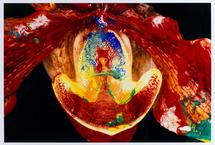The Galería Javier López & Fer Francés is taking part in the twenty-second OFF Festival of PHotoESPAÑA with a solo exhibition by the Japanese artist Nobuyoshi Araki (b. Tokyo, 1940) curated by Jimena López. It includes a wide range of colour and black-and-white photographs focused on two of the themes that have gained him greatest international recognition over the last four decades: flowers and portraits of women.
If other contemporary artists—in literature and cinema as much as the visual arts—have made the cities where they live and work the centre of their narrative discourse, Araki has assuredly created an image of Tokyo that shows a very personal point of view, which remains, at the same time, deeply rooted in the collective imagination of Japan’s capital city. His first sequences of empty urban landscapes, such as Tokyo Autumn (1972), were taken as he wandered through the strangely deserted streets of that emblematic city with a small Leica. He immediately discovered the famous red-light district of Shinjuku, where the endless variations of femininity exercised such a powerful fascination on him that they could be said to have determined his later work.
Araki’s work has always been situated on the borderline between artistic expression and pornography, and since the nineties he has become a cult figure and a classic of contemporary photography, known for his unique, sometimes disturbing, take on eroticism. His work brings together life, death, sex and beauty—a beauty as fleeting as that of flowers, symbols of decay. In the seventies, early on in his career, he had problems with the authorities, and was charged with immorality; in 1988 the magazine Shashin Jidai was seized by police for publishing photographs of his; some of his exhibitions had to be closed or censored, and in 1993 a curator was arrested for showing his images of nudes. But Araki has stayed right at the limit of socially tolerated provocation, playing with the role of rebel without presenting a threat to anything except moral values and cultural taboos.
Two registers can be seen in his controversial work: a sentimentalism that verges on kitsch and an extreme eroticism that is at times downright pornographic, and in some series both are in evidence at the same time—for example, Tokyo Nude in the eighties, A’s Paradise in 1998, and Vaginal Flowers in 1999. The death of his wife in 1991 left a void that the artist sought to fill with photography, and since then he has refused to photograph anything that is not life, while discovering that every image involves a death: that of time stopped.
A prolific artist and the creator of numerous books, Araki first took part in the Venice Biennale in 1979, and since then his work has been the subject of multiple travelling retrospectives both in Europe and the United States. In Spain, the first group exhibition to include his photography was at Barcelona’s Casa Edizalde in 1986; the Sala Parpalló in Valencia presented his work together with that of Larry Clark in 1994; he took part in the first Valencia Bienal in 2001 and in the PHotoESPAÑA Festival in 2002 and 2013.
Text: Jimena López
Download as PDF (225 K)